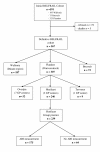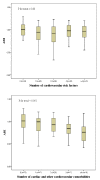To screen or not to screen for peripheral arterial disease in subjects aged 80 and over in primary health care: a cross-sectional analysis from the BELFRAIL study
- PMID: 21605447
- PMCID: PMC3121584
- DOI: 10.1186/1471-2296-12-39
To screen or not to screen for peripheral arterial disease in subjects aged 80 and over in primary health care: a cross-sectional analysis from the BELFRAIL study
Abstract
Background: Peripheral arterial disease (PAD) is common in older people. An ankle-brachial index (ABI) < 0.9 can be used as an indicator of PAD. Patients with low ABI have increased mortality and a higher risk of serious cardiovascular morbidity. However, because 80% of the patients are asymptomatic, PAD remains unrecognised in a large group of patients. The aims of this study were 1) to examine the prevalence of reduced ABI in subjects aged 80 and over, 2) to determine the diagnostic accuracy of the medical history and clinical examination for reduced ABI and 3) to investigate the difference in functioning and physical activity between patients with and without reduced ABI.
Methods: A cross-sectional study embedded within the BELFRAIL study. A general practitioner (GP) centre, located in Hoeilaart, Belgium, recruited 239 patients aged 80 or older. Only three criteria for exclusion were used: urgent medical need, palliative situation and known serious dementia. The GP recorded the medical history and performed a clinical examination. The clinical research assistant performed an extensive examination including Mini-Mental State Examination (MMSE), Geriatric Depression Scale (GDS-15), Activities of Daily Living (ADL), Tinetti test and the LASA Physical Activity Questionnaire (LAPAQ). ABI was measured using an automatic oscillometric appliance.
Results: In 40% of patients, a reduced ABI was found. Cardiovascular risk factors were unable to identify patients with low ABI. A negative correlation was found between the number of cardiovascular morbidities and ABI. Cardiovascular morbidity had a sensitivity of 65.7% (95% CI 53.4-76.7) and a specificity of 48.6% (95% CI 38.7-58.5). Palpation of the peripheral arteries showed the highest negative predictive value (77.7% (95% CI 71.8-82.9)). The LAPAQ score was significantly lower in the group with reduced ABI.
Conclusion: The prevalence of PAD is very high in patients aged 80 and over in general practice. The clinical examination, cardiovascular risk factors and the presence of cardiovascular morbidity were not able to identify patients with a low ABI. A screening strategy for PAD by determining ABI could be considered if effective interventions for those aged 80 and over with a low ABI become available through future research.
Figures
References
-
- Meijer WT, Grobbee DE, Hunink MG, Hofman A, Hoes AW. Determinants of peripheral arterial disease in the elderly: the Rotterdam study. Arch Intern Med. 2000;160:2934–2938. - PubMed
-
- Bartelink ML, Stoffers HEJH, Boutens EJ, Hooi JD, Kaiser V, Boomsma LJ. NHG-standaard Perifeer arterieel vaatlijden. Huisarts Wet. 2003;46:848–858.
-
- Fowkes FGR, Housley E, Cawood EHH, Macintyre CCA, Ruckley CV, Prescott RJ. Edinburgh Artery Study: prevalence of asymptomatic and symptomatic peripheral arterial disease in the general population. Int J Epidemiol. 1991;20:384–392. - PubMed
-
- Schroll M, Munck O. Estimation of peripheral arteriosclerotic disease by ankle blood pressure measurements in a population of 60-year-old men and women. J Chronic Dis. 1981;34:261–269. - PubMed
-
- Stoffers HE, Kester AD, Kaiser V, Rinkens PE, Kitslaar PJ, Knottnerus JA. The diagnostic value of the measurement of the ankle-brachial systolic pressure index in primary health care. J Clin Epidemiol. 1996;49:1401–1405. - PubMed
Publication types
MeSH terms
LinkOut - more resources
Full Text Sources
Medical



